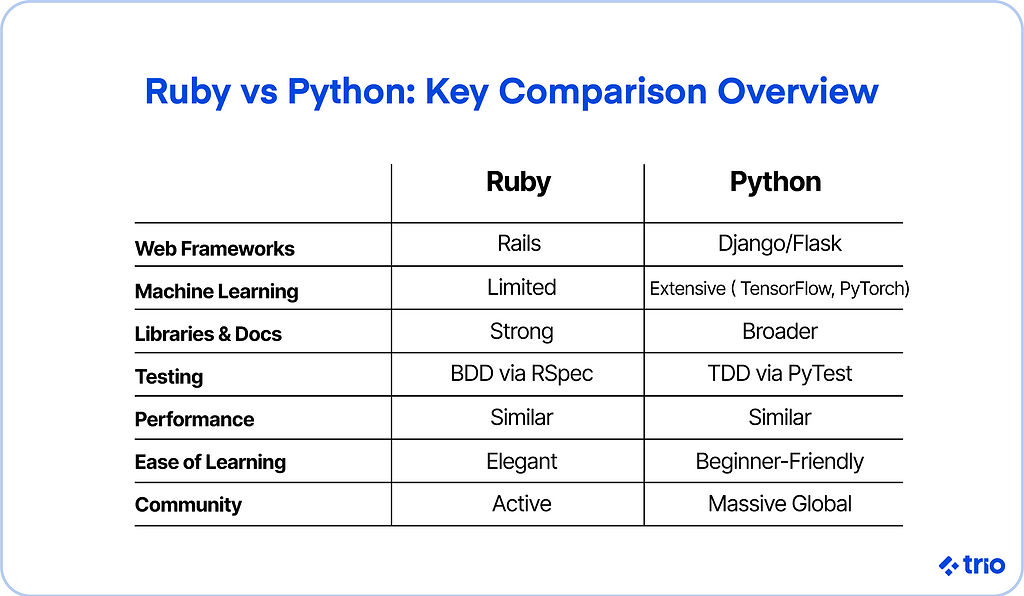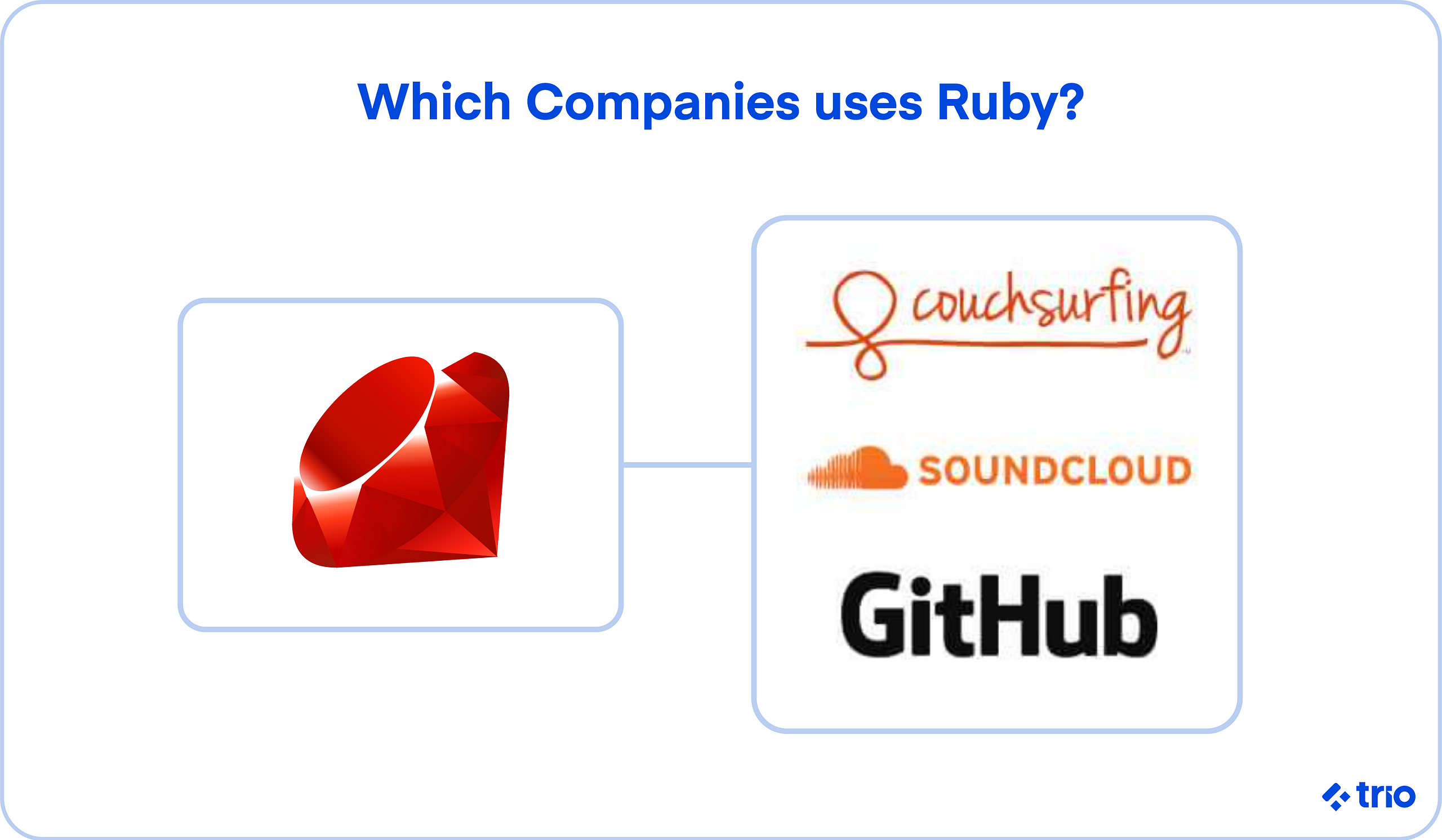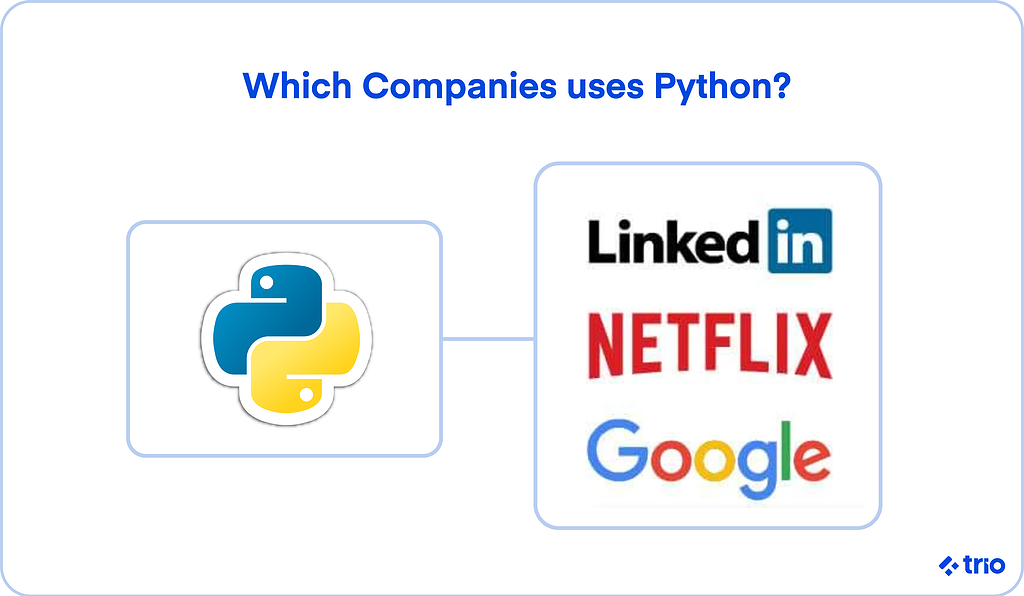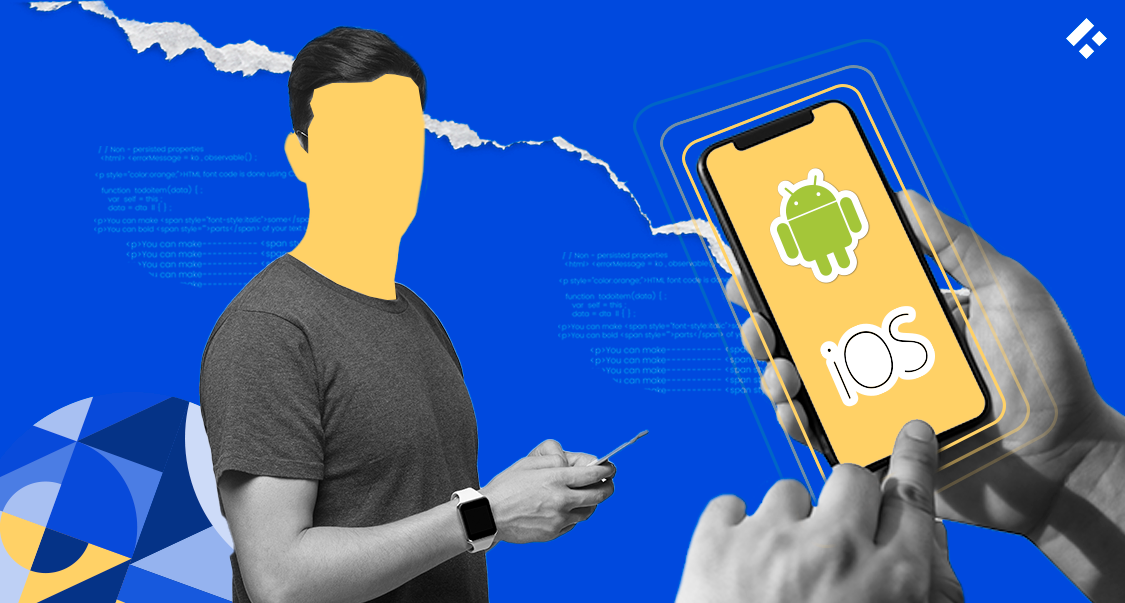Ruby vs Python may or may not be your top concern right now, but if you’re a business leader, startup founder, or developer planning for 2025, the choice between the two can significantly shape your project’s success.
Whatever the case may be, if you’re asking which programming language you should choose for the new year and Ruby vs. Python is running circles in your mind, don’t be alarmed.
Both Ruby and Python are high-level, open-source languages with elegant syntax, strong communities, and a proven track record.
Though Python actually carries a distinctive advantage over Ruby, observing how Python vs. Ruby compare side-by-side can further your understanding of how they contrast, given the following attributes:
- Web Framework
- Machine Learning
- Documentation & Libraries
- Testing Environment
- Performance
- Learning Curve
- Community & Popularity
The good news is: you don’t have to guess. Trio’s engineering team has built and scaled applications in both Ruby and Python, and we’ve studied the real-world trade-offs that matter most to businesses.
Using this information, you can decide which programming language will fuel your next project.
Are you ready to start your development project?
We have the developers you need to take your development project in the right direction.
Companies are proven to grow their business faster with Trio.
Ruby vs Python: Side-by-Side Comparison
It’s important to compare Ruby and Python side-by-side to understand their differences and similarities, and where they stand competitively. Here goes.
| Category | Ruby | Python |
|---|---|---|
| Learning Curve | Easy to learn, elegant syntax, but less beginner support compared to Python. | One of the most popular languages worldwide, with a vast, diverse community. |
| Web Development | Rails is excellent for fast MVPs and startups. | Django and Flask scale well for enterprise and flexible projects. |
| AI & Machine Learning | Limited libraries and ecosystem support. | Dominant in AI/ML with TensorFlow, PyTorch, and scikit-learn. |
| Libraries & Ecosystem | RubyGems offers solid libraries but is smaller in scope. | Massive ecosystem (PyPI has 300k+ packages), “batteries-included” approach. |
| Performance | Comparable to Python; speed largely depends on framework optimization. | Comparable to Ruby; can be optimized with C extensions. |
| Community & Popularity | Active but niche; strongest around Rails. | One of the most popular languages worldwide with a vast, diverse community. |
| Career Opportunities (2025) | Still in demand for Rails developers in startups and SaaS companies. | Extremely strong job market across data science, web, AI, and enterprise systems. |
| Average Salary (US) | ~$129,600 (Rails-focused roles). | ~$127,227 (AI, data science, full stack roles). |
Web Framework
When you compare Ruby and Python’s respective frameworks, Ruby on Rails and Django/Flask, you’ll find them strikingly similar. Both use the MVC pattern, have strong libraries, and maintain large repositories (RubyGems for Ruby and PyPI for Python).
TL;DR: Both frameworks are excellent for web development. Rails excels at rapid MVPs and startups, while Python’s frameworks scale smoothly for larger enterprise systems.
Machine Learning
Python’s ecosystem makes it the go-to language for AI and machine learning. Libraries like TensorFlow, PyTorch, and scikit-learn dominate the field, and most machine learning courses expect Python proficiency.
Ruby, while elegant, still has limited support here. Ruby’s ML/AI libraries are growing, but nowhere near Python’s maturity.
TL;DR: Python is the clear winner in machine learning.
Documentation & Libraries
RubyGems and PyPI both provide extensive libraries, but Python’s ecosystem is broader, more mature, and better documented. This maturity comes from both its popularity and its age.
TL;DR: Python wins on libraries and documentation.
Testing Environment
Both languages embrace test-driven development (TDD). Python offers PyTest and unittest to support good coding practices. Ruby, however, has a unique edge with behavior-driven development (BDD) via RSpec, which lets developers align code with clear requirements.
TL;DR: Both are strong in testing, but Ruby edges ahead with BDD.
Performance
Both Python and Ruby are interpreted, open-source languages. In practice, their performance is comparable, and much depends on framework choice and optimization.
TL;DR: Performance is a tie.
Learning Curve
Ruby is known for its elegant, English-like syntax. But Python is often considered even more beginner-friendly, taught in schools and universities worldwide.
TL;DR: Python wins for ease of learning.
Community & Popularity
Both Ruby and Python benefit from large, active open-source communities. Ruby’s popularity is tied closely to Rails, while Python has grown into one of the most widely used languages globally, especially in education, data science, and AI.
TL;DR: Both have strong communities, but Python’s reach is far greater.

Career Opportunities & Salaries (2025)
For many developers and businesses, choosing between Ruby and Python isn’t just about syntax or frameworks — it’s about career paths and hiring opportunities. In 2025, the job market will clearly reflect the strengths of each language.
Ruby Career Outlook
Ruby remains closely tied to web development and SaaS companies. Roles for Ruby developers most often involve building and maintaining applications on Rails, which continues to power platforms like Shopify, Airbnb, and GitHub.
- Job Demand: Ruby job postings are steady but concentrated in startups and product-focused companies.
- Salary Range (US): According to Glassdoor, the average Ruby Developer salary is about $123,560/year, and Ruby on Rails Developer salaries average around $129,600/year in the US Senior Ruby roles can reach well above $150k, though opportunities are fewer compared to Python.
- Global Trend: Ruby is less in demand outside web development, which narrows career flexibility compared to Python.
Python Career Outlook
Python is consistently ranked as one of the most in-demand programming languages worldwide. Its versatility across fields like data science, AI, web development, and automation makes it a strong career investment.
- Job Demand: Python roles span industries from finance to healthcare to tech giants. It is also the most frequently mentioned language in developer job listings on LinkedIn.
- Salary Range (US): On Glassdoor, the average Python Developer salary is about $127,227/year. Job postings in high-demand markets like New York often list a range from $97,000–$168,000. Data science and AI specialists frequently command salaries above this range.
- Global Trend: Python is used everywhere — from startups to enterprises — and continues to grow thanks to its role in emerging technologies like AI and machine learning.
TL;DR: Ruby careers are lucrative but niche, tied closely to Rails. Python careers are broader, more flexible, and higher-paying overall, especially in AI and data-driven industries.

But how do Ruby and Python fare outside of the throes of competition? Look below to find out.
What Is Ruby?
Ruby is a high-level, interpreted, general-purpose programming language. The language was created in 1995 by Yukihiro “Matz” Matsumoto with the goal of making programming both productive and enjoyable. His objective was to create an object-oriented scripting language that was easier to use than alternatives like Perl.
General-purpose languages like Ruby are designed for writing software in multiple environments. For the most part, Ruby is used for web applications, e-commerce platforms, and SaaS products. But it also works for data analysis, prototyping, and proofs of concept.
As an interpreted language, Ruby is almost by definition slower than compiled languages. Compiled languages are converted directly into machine code before execution, whereas interpreted languages are executed line by line. Still, for most business use cases, the difference in speed is negligible compared to development productivity.
Ruby also supports multiple programming paradigms. Of course, there’s object-oriented programming, but Ruby also allows for functional programming and procedural programming, making it flexible for developers with different preferences.
Dynamic typing is another asset of Ruby, permitting more lenient rules when it comes to defining variable types before their use. The result is succinct and easier-to-write code. However, static typing, in contrast, has the advantage of detecting type errors more efficiently.
For memory management, Ruby has garbage collection. This means tasks like storing active objects in memory and discarding unused ones happen automatically.
Aside from its features, Ruby is known for being an elegant, easy-to-write language. Many developers compare coding in Ruby to writing in English.
What Are the Advantages of Ruby?
Ruby’s main advantages stem from its developer productivity. Many features of its syntax and dynamic nature play into this strength.
- Elegant: Ruby is often a first language because it’s easy to learn and mirrors English.
- Fast to Build: Despite being interpreted, Ruby is known for its rapid development speed. Developers using Ruby on Rails often report building applications 30–40% faster than with comparable frameworks.
- Intentional: Ruby was created to improve on languages like Perl and Python. It is more organized than Perl and more purely object-oriented than Python.
- Easy: Features like metaprogramming allow Ruby to predict and generate code dynamically, reducing boilerplate.
When Is the Use of Ruby Recommended?
Ruby’s best use is for building web applications. You can give Ruby on Rails the credit for Ruby’s fame in this field. No web developer can go long without hearing about Ruby on Rails.
For context, Ruby on Rails is a web application framework that provides default structures for databases, web services, and web pages, utilizing an MVC pattern. It also emphasizes useful software engineering paradigms, such as ‘convention over configuration’ (CoC) and ‘don’t repeat yourself’ (DRY).
Since the stable release of Ruby on Rails in 2005, the framework has had a great impact on web development, influencing later frameworks in many languages. In 2025, Rails remains a strong choice for startups and SaaS companies that need to get products to market quickly.
All that said, Ruby has the capacity to shine on a variety of platforms. You can use Ruby for many applications, like e-commerce, content management, and even games.
What Companies Use Ruby?
Due to the advantages of using Ruby, many major companies have incorporated the language into their tech stack. Knowing which companies use Ruby and why might give you a better understanding of which language stands out the most when it comes to Ruby vs. Python.

GitHub
GitHub is a repository where developers can store code and collaborate with other developers using version control. As a GitHub user, you can thank Ruby on Rails for the fundamentals of the platform.
Sam Lambert, the database administrator for GitHub, maintains that Ruby helps GitHub improve their scalability.
Couchsurfing
Couchsurfing is a website hosting a network where locals and travelers can connect. In this way, curious wanderers visiting new places can stay with locals – typically for free – and meet people in the area.
Here, too, Ruby on Rails asserts its dominance in web development. The framework is a defining part of Couchsurfing’s tech stack.
Soundcloud
Soundcloud is an online music distribution platform. Users on SoundCloud can upload their own music or that of others, as well as share, promote, and stream the audio.
Ruby is the language of choice for Soundcloud’s application programming interface (API) wrapper.
An API is a software intermediary allowing different applications to communicate with each other. API wrappers are language-specific and enable the automation of easy-to-use functions via multiple APIs wrapped into a single package.
What Is Python?
Python shares similar traits with Ruby. Created only four years before Ruby, Python is an interpreted, high-level general-purpose language. The language is also dynamically typed with garbage collection.
Designed by Guido van Rossum, Python is embedded with the philosophy of code readability. From the start, Python was designed with the philosophy of code readability and simplicity.
Like Ruby, Python is dynamically typed and includes garbage collection. But Python’s most defining feature is its emphasis on clarity, making it a favorite for beginners and professionals alike.
Python supports multiple programming paradigms. It is primarily object-oriented but also fully supports procedural and functional programming. The use of significant whitespace to denote code blocks is unique to Python — a design choice that some developers find restrictive but most appreciate for enforcing clean, readable code.
Another standout strength is Python’s “batteries included” philosophy. Its standard library is robust, covering everything from file I/O to web protocols. And in 2025, PyPI hosts more than 300,000 third-party packages, making Python one of the most versatile ecosystems in programming.
The Zen of Python is a document summarizing the language’s core philosophies using concise and pointed language. Here are a few examples of text in the document:
- “Beautiful is better than ugly.”
- “Sparse is better than dense.”
- “There should be one – and preferably only one – obvious way to do it.”
- “If the implementation is hard to explain, it’s a bad idea.”
- “Namespaces are one honking great idea – let’s do more of those!”
What Are the Advantages of Python?
Python’s biggest advantages are its simplicity, versatility, and career relevance.
- Easy: The syntax is clean and concise, often requiring fewer lines of code than other languages.
- Extensive: With both a robust standard library and hundreds of thousands of external packages, Python can handle everything from web development to AI.
- Portable: Python runs on most operating systems without modification.
- Productive: Built-in data structures like lists and dictionaries help developers solve problems faster.
When Is the Use of Python Recommended?
Python is widely used in web development thanks to frameworks like Django and Flask. Django emphasizes rapid development and security, while Flask offers flexibility as a lightweight microframework.
Beyond web development, Python dominates in data science, machine learning, and AI. Libraries like Pandas, NumPy, TensorFlow, and PyTorch make it the standard language for data-driven projects.
Python also excels at automation and scripting, which has made it a staple in both enterprise IT and everyday developer workflows. In 2025, Python is often the first language taught in universities and remains one of the top choices for anyone entering the field.
What Companies Use Python?
Several major companies use Python, making the language a competitive contender for the Ruby vs. Python debate.

LinkedIn is a combination of social networking and job boards. Both individuals and companies can sign up for LinkedIn and make their professional information publicly available.
Flask is partially responsible for LinkedIn’s creation. You can bet LinkedIn developers chose Flask because of its minimalist characterization.
Netflix
If you don’t already know, Netflix is a popular streaming platform for movies and series. With a recurring monthly fee, Netflix users can access several thousand titles across various genres.
Netflix utilizes Python to run chaos engineering tests and integrate the various codebases across their tech stack.
Google needs no explanation. It’s more likely than not that you’ve encountered Google in one way or another.
Python serves as one of Google’s three core languages, along with Go and Java. It’s not exactly clear how Google uses Python, but they’ve shown official support for its usage.

Elevate Your Team with Trio AI Talent
Empower Your Projects with Trio’s Elite Tech Teams
Conclusion
Python and Ruby share many characteristics to the point that it is hard to distinguish between them. They are both high-level languages with simple syntax. Both languages demonstrate dexterity with web applications and a wide range of uses.
Despite their similarities, the area where these languages differ may be important to consider for scaling businesses. A side-by-side comparison of Ruby and Python in close-up reveals that in certain areas, Python outperforms Ruby.
Looking for qualified Python developers? Trio has professional Python developers who have been trained and vetted to do just what you need to take your business to the next level.
FAQ
Is Ruby easier than Python for beginners?
Ruby is easy to read and elegant, but Python is considered easier for beginners because its syntax is closer to natural language.
What is Ruby best used for in 2025?
Ruby is best used for building web applications, especially SaaS and marketplace platforms with Ruby on Rails.
What is Python best used for in 2025?
Python is best used for data science, AI, machine learning, automation, and scalable web applications.





